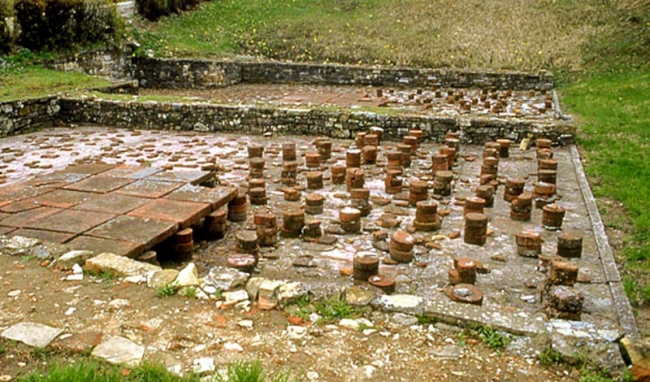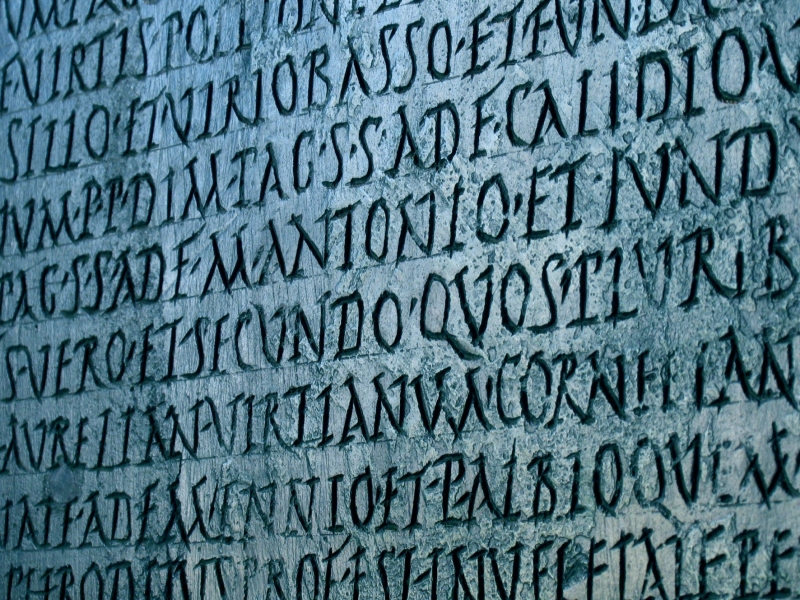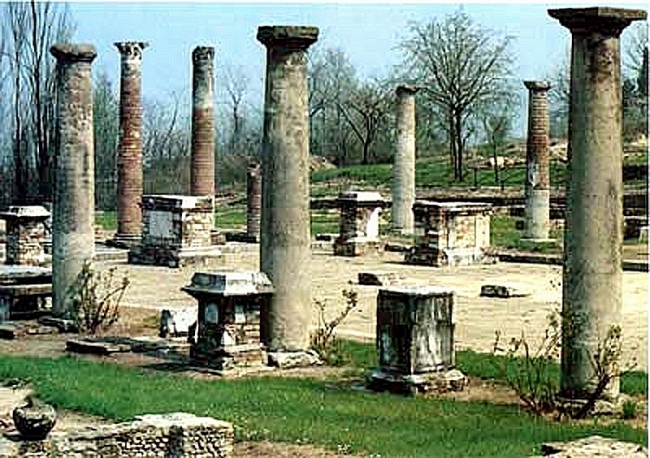Room II
The discovery and the excavations
"citra Placentiam in collibus oppidum est
Veleiatium"
on the hills at South of Piacenza there is the town of Veleia and his
citizens
(Plinio, Nat. Hist. VII 163)
The existence of the roman city of Veleia has been certified by ancient
sources but any further information, including the area where it was built, had
been lost soon. In 1747 the dean of the Macinesso Parish Church found the
fragments of a bronze inscription and, unaware of its great value, sold them to
the nearby foundries. Fortunately, it had not been destroyed thanks to a scholar
(of that period) that recognised its artistic value and, together with Antonio
Costa, canon of/in the Cathedral of Piacenza, bought the missing fragments.
Two years later, two scholars, Ludovico Muratori and Scipione Maffei, identified
the Tabula Alimentaria traianea , the institution established by Nerva and
developed/pushed ahead by his successor, Trajan.
Muratori also realized that the place where they had found the inscription was
the site of the ancient Veleia.
After this remarkable discovery, the Duke of Parma don Filippo I di Borbone,
aiming at competing with his brother, the Duke Carlo III, that was exploring at
that time the roman site of Pompeii, officially started the excavations and, a
few months later, founded/established the Ducal Museum of Antiquities, now the
National Archaeological Museum of Parma, in order to receive the findings.

A view of the Archaeological Excavations of the Roman town of Veleia
From 1760 to 1765 almost the whole of the ruins of Veleia were unearthed: in
1760 the excavations unveiled the forum and the surrounding portico; in 1761 the
basilica disclosed twelve marble statues portraying members of the Julio-Claudian
Family; then, the excavations reached the upper terraces, that revealed the
thermal centre and the surrounding houses.
The excavations in Veleia came to a first stop with the death of the Duke, and
started again in 1800, first with the Duchess Maria Luigia, then under the
control of the directors of the Museum. In 1876 Giovanni Mariotti found the
ligurian necropolis with the cinerary urns in the north-east area of the roman
settlement.
The efforts of the following directors were focused above all on the restoration
works of the buildings. During the last research, in the 1960s, the employment
of new scientific methods allowed the chronologic distinction of the different
building phases and the correct interpretation of some buildings, such as the
castellum acquae ( the water tank or reservoir ) that, correctly recognized in
1763, was then misinterpreted as the amphitheatre and as such restored at the
beginning of the XIX century.
The history
The Roman city of Veleia was founded after the defeat in 158 BC of the
Ligures Veleiates who fought against the Roman expansion, with the aim of
controlling and managing a huge mountain area between the Taro and the Trebbia
Valleys. The most ancient burials, which were discovered there in 1876, belonged
to a pre-existing local settlement.
Shortly after the first half of the I century BC it became a Roman municipality,
acquiring the right of citizenship, and witnessed a season of development with
the construction of monuments and buildings: the marble statues of the Julio-Claudian
cycle discovered in the basilica and the huge number of monuments are evidence
of the important relations held with the imperial family. But this state of
prosperity did not last long: in the first half of the II century AD the
concession of the Alimenta, the Institution founded by Trajan, showed the
interest afforded by the central authority to the economic crisis of the city,
where the landed property was under the control of a few rich landowners and
many lands were taken up by woodlands or used for pasture, with the obvious
consequence that there was a large number of poor people among the small
landowners.
The study of toponymic and onomastic data clearly shows that Veleia was a Roman
city in a never completely Romanized context: besides the Latin names, we can
find names and surnames of Ligurian origin, such as Ligurinus and Ligus, as well
as Celtic elements, such as Noviodunos ( from the Celtic novio = new and dunos =
fortress).
From the III century AD on the crisis is clear: life in the city is witnessed
until the V century AD at least. The end of Veleia can be placed in the general
trend of depopulation of that time, after the fall of the Western Roman Empire,
when a lot of Italian cities were abandoned.
A parish church devoted to Saint-Anthony ( the “Pieve di Sant’Antonino”) has
been erected on the area of the ancient Veleia, now completely buried.
The Roman city
Veleia looks like a typical mountain centre, with its buildings placed on a
terraced hillside, partly natural and partly artificial, and the structures for
the religious, social and civil life (the latter belonging to the most powerful
families) organized around the forum.
The forum of Veleia was formed by a square, paved by slabs of sandstone, closed
on one side by the basilica, where justice was administered and public functions
carried out; it was surrounded on the other three sides by a portico, with the
tabernae (the shops). In the main room of the basilica, statues of marble from
Luni, portraying the members of the Julio-Claudian family, were aligned on a
podium against the back wall.
In the second half of the I century AD, on the northern side, facing the
basilica, a monumental entrance with columns on two sides was placed to connect
the inner portico with a new one, probably planned for public use.
On the upper terrace, overlooking the basilica, there are the ruins of the bath
(thermal spa), belonging to the Imperial period, and the built-up southern
district, including the Domus del cinghiale, a clear example of a Roman house
with atrium.
The present appearance dates back to the Imperial period but traces of more
ancient times have been unearthed in different areas of the town.

Ruins of the bath (thermal spa) - Archaeological site of Veleia
The bronze items
The bronze items, produced mostly by workshops in the North of Italy, are artefacts of a high quality. Among these, the most remarkable are a head of girl (end I century BC), a head of emperor (room 4), probably the portrait of Antoninus Pius (138-161 AD), a winged Victory (I century AD), certainly part of a commemorative monument, and a votive statuette representing a drunken Hercules (II century AD).


Left: Winged Victory (I century AD) - Right: Drunken Hercules (II century AD)
Room III
The Julio-Claudian cycle of marble statues
The twelve statues of marble from Luni, portraying the members of the Julio-Claudian
family, were aligned on the podium of the basilica for clearly commemorative
purposes and represent today the political propaganda of the imperial family in
the North of Italy. They probably all had dedication plaques, but only five of
them still survive. In the case of Veleia, the link with the imperial court is
represented by L. Calpurnio Pisone, patron of the city and Julius Caesar’s
brother-in-law.
The religious significance attached to the cult of the imperial family is
witnessed by the high number of togaed figures and statues with veiled heads (in
latin, “velato capite” statues).
The cycle seems to have been realized at different moments: the first group,
under Tiberius’s rule, consisting of Tiberius himself (headless), Augustus and
Livia (Tiberius’s mother), the two Drusi, Major and Minor (brother and son of
the Emperor) and the realistic portrait of Lucio Calpurnio Pisone Pontifex, who
most probably commissioned them. The statue of L. Calpurnio Pisone follows the
classical representation of the pontifex with veiled head, modelled on the
portrait of Via Labicana, Rome. The identification of two headless statues with
the figures of Augustus and Livia was possible thanks to their corresponding
dedicatory plaques.

Marble statues of the
Julius-Claudian cycle from the Basilica of Veleia
The second group was formed by Caligula, whose head had been replaced after his
damnation memoria, that is the condemnation of the figure depicted, his sister
Drusilla and his mother Agrippina Major.
In the third group there is the statue of Claudius, whose head replaces
Caligula’s, together with his last wife, Agrippina Minor, and her little son,
Nero.
Finally, a loricate statue, whose identification with Domitian or Germanicus is
still controversial among scholars. In any case its head was used again
afterwards, probably in honour of Nerva.
Room IV
The Tabula Alimentaria
This wide inscribed bronze table (m 1,38 x 2,86), found in 1747 in the site
of Veleia, represents a document of great value since it witnesses the
institution for the city of the alimenta, a mortgage loan granted by the Emperor
to the landowners of that area, and whose interest was allocated for the
maintenance of poor children. It was a great financial action established by the
Emperor Nerva (96-98 AD) and developed by his successor, Trajan, in order to
support young people who could guarantee to the Empire future generations of
soldiers and officials of Italic origin. The emperor’s main purpose was to
prevent the fall in population and the economic decline of Italy at the
beginning of the II century AD. The Tabula Alimentaria showed the Emperor’s
instructions (ex indulgentia optimi maximique principis) for the institution of
a indefinite mortgage loan on lands (obligation praedorium), directly paid out
from his private coffers (fiscus). The loan was divided into two consecutive
disbursements in sestertii and the interests, at a rate of 5% per year, were
allocated in sestertii or in kind (wheat) to 245 legitimate sons and 34
legitimate daughters, plus an illegitimate son and a daughter. This grant
corresponded to the essential minimum sum a person could survive on.
The loan was granted to Veleia and to some neighbouring cities, such as
Piacenza, Parma, Libarna and Lucca, in proportion to their landed properties.
The landowners were listed in more than six columns, indicating their names, the
name of the intermediaries, the estimation of the properties (eastimatio) and
the sum of money paid out. Then, the name of the land (vocabulum) and of two
neighbouring lands at least, its use, its structures (farmhouses, sheepfolds and
furnaces), and its location in the district (pagus) or in a village (vicus).
This inscription offers undoubtedly a cross-section of the condition of the
Apennines near Piacenza at the beginning of the II century AD, revealing the
gradual building of landed properties, despite the prevalence of pastoral
activities that consequently brought about a limited exploitation of the land,
and the coexistence of the local people together with the Roman citizens,
through the study of toponymic and onomastic data.

The Tabula Alimentaria (particular) - Archaeological National Museum of Parma
Public areas
The forum represented the centre for commercial, social, legal and political
activities: besides the essential civil buildings and the surrounding shops, it
also contained the most important commemorative monuments of the city.
The bases of two equestrian statues, dedicated to Claudius (in 42 AD) and
Vespasian (in 71 AD) respectively, are still recognizable, as well as a cippus
of red marble from Verona for the emperors’ worship and the bases of two other
statues, one dedicated to Tranquillina, Gordanius Pius’s wife, and Probus, and
the other to Aurelian (III century AD).
Then, a series of inscriptions, both political and religious, that had to be
manifested publicly, such as the Inscription in honour of Coelio Festo, The
Tabula Alimentaria, and a smaller bronze tablet found in the ruins of the
portico, bearing part of the Lex de Gallia Cisalpina (49 BC), were displayed
there; the Lex is an invaluable text which gives information about Roman civil
procedure and regulates the authority of Roman magistrates who had the faculty
of judging cases not exceeding the value of 15.000 sestertii.
The forum also permitted the display of monuments and inscriptions in honour of
some deserving citizens who had accomplished or renewed public works.

The Veleia's forum
The fragment of wall painting, in third Pompeian style, portraying a garden enclosed with trellises (beginning I century AD) was discovered in the northern area of the portico.
Private areas
Elements of house furniture and crockery, ornamental objects and glassware
found in Veleia, allow us to reconstruct the high level of wealth reached by the
city (showcase 1).
First of all the settlement had a complex network of pipes (fistulae) to supply
water from a huge reservoir (castellum acquae) to the built-up area below.
Windows were closed with wood-framed panels, while a heating system was found in
the bath and in other public buildings.
Both indoors and outdoors, the houses reflected the Roman concept of the living
area as a private and official space, where the expression of power and wealth
was at the basis of the social relationships between the leading classes, the
“patrons” (patroni) and their subordinates, the “clients” (clientes). It was
precisely in these official rooms that mosaic floors and fine furnishings, such
as bronze oil-lamps, used single or like candelabra, were more often employed.
Terracotta oil-lamps were used by common people for everyday life.
The high-quality bronze material discovered in Veleia was not manufactured in
this area; for instance, the female bust within circular clypeus, the sconce
with the warrior bust, and the furniture base with the warrior in combat, were
Cisalpine productions; the pelike, a bronze jug, damascened with silver ( I
century BC) was a Southern Italian production, and the sconces with bust of
Silenus and juvenile bust, supports of a triclinium bed, came from the eastern
Mediterranean.
The comfort of everyday life is certified by the large number of objects used
for body care (showcase 2): glass unguentary vases and balsamaria (balm vases),
strigils, used to wipe sweat and dust off after gymnastic exercises or to remove
oils and unguents after bathing; spatulae, tweezers, beauty products and
toiletries. Then, fibulae, rings and pins represented the essential ornaments
for clothes and hair.
In every Roman house, whether rich or humble, small altars (larari) were devoted
to the worship of ancestors or household gods, the lares. A small statue,
portraying a veiled head offerer (first half of the I century AD), represents
the transposition of the official religion and the emperors’ cult in a domestic
location. In the middle of imperial age, the diffusion of the cult of Isis, the
Egyptian divinity, frequently identified with the Goddess Fortuna, reached its
peak throughout the Roman world.

Precious glass cup (patera) (end of I century B.C.- beginnings of I century
A.D.)